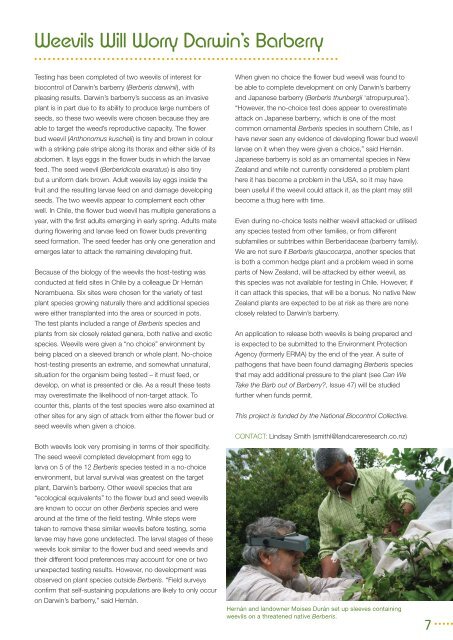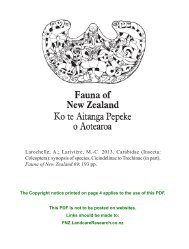PDF File - Landcare Research
PDF File - Landcare Research
PDF File - Landcare Research
You also want an ePaper? Increase the reach of your titles
YUMPU automatically turns print PDFs into web optimized ePapers that Google loves.
Weevils Will Worry Darwin’s Barberry<br />
Testing has been completed of two weevils of interest for<br />
biocontrol of Darwin’s barberry (Berberis darwinii), with<br />
pleasing results. Darwin’s barberry’s success as an invasive<br />
plant is in part due to its ability to produce large numbers of<br />
seeds, so these two weevils were chosen because they are<br />
able to target the weed’s reproductive capacity. The fl ower<br />
bud weevil (Anthonomus kuscheli) is tiny and brown in colour<br />
with a striking pale stripe along its thorax and either side of its<br />
abdomen. It lays eggs in the fl ower buds in which the larvae<br />
feed. The seed weevil (Berberidicola exaratus) is also tiny<br />
but a uniform dark brown. Adult weevils lay eggs inside the<br />
fruit and the resulting larvae feed on and damage developing<br />
seeds. The two weevils appear to complement each other<br />
well. In Chile, the fl ower bud weevil has multiple generations a<br />
year, with the fi rst adults emerging in early spring. Adults mate<br />
during fl owering and larvae feed on fl ower buds preventing<br />
seed formation. The seed feeder has only one generation and<br />
emerges later to attack the remaining developing fruit.<br />
Because of the biology of the weevils the host-testing was<br />
conducted at fi eld sites in Chile by a colleague Dr Hernán<br />
Norambuena. Six sites were chosen for the variety of test<br />
plant species growing naturally there and additional species<br />
were either transplanted into the area or sourced in pots.<br />
The test plants included a range of Berberis species and<br />
plants from six closely related genera, both native and exotic<br />
species. Weevils were given a “no choice” environment by<br />
being placed on a sleeved branch or whole plant. No-choice<br />
host-testing presents an extreme, and somewhat unnatural,<br />
situation for the organism being tested – it must feed, or<br />
develop, on what is presented or die. As a result these tests<br />
may overestimate the likelihood of non-target attack. To<br />
counter this, plants of the test species were also examined at<br />
other sites for any sign of attack from either the fl ower bud or<br />
seed weevils when given a choice.<br />
Both weevils look very promising in terms of their specifi city.<br />
The seed weevil completed development from egg to<br />
larva on 5 of the 12 Berberis species tested in a no-choice<br />
environment, but larval survival was greatest on the target<br />
plant, Darwin’s barberry. Other weevil species that are<br />
“ecological equivalents” to the fl ower bud and seed weevils<br />
are known to occur on other Berberis species and were<br />
around at the time of the fi eld testing. While steps were<br />
taken to remove these similar weevils before testing, some<br />
larvae may have gone undetected. The larval stages of these<br />
weevils look similar to the fl ower bud and seed weevils and<br />
their different food preferences may account for one or two<br />
unexpected testing results. However, no development was<br />
observed on plant species outside Berberis. “Field surveys<br />
confi rm that self-sustaining populations are likely to only occur<br />
on Darwin’s barberry,” said Hernán.<br />
When given no choice the fl ower bud weevil was found to<br />
be able to complete development on only Darwin’s barberry<br />
and Japanese barberry (Berberis thunbergii ‘atropurpurea’).<br />
“However, the no-choice test does appear to overestimate<br />
attack on Japanese barberry, which is one of the most<br />
common ornamental Berberis species in southern Chile, as I<br />
have never seen any evidence of developing fl ower bud weevil<br />
larvae on it when they were given a choice,” said Hernán.<br />
Japanese barberry is sold as an ornamental species in New<br />
Zealand and while not currently considered a problem plant<br />
here it has become a problem in the USA, so it may have<br />
been useful if the weevil could attack it, as the plant may still<br />
become a thug here with time.<br />
Even during no-choice tests neither weevil attacked or utilised<br />
any species tested from other families, or from different<br />
subfamilies or subtribes within Berberidaceae (barberry family).<br />
We are not sure if Berberis glaucocarpa, another species that<br />
is both a common hedge plant and a problem weed in some<br />
parts of New Zealand, will be attacked by either weevil, as<br />
this species was not available for testing in Chile. However, if<br />
it can attack this species, that will be a bonus. No native New<br />
Zealand plants are expected to be at risk as there are none<br />
closely related to Darwin’s barberry.<br />
An application to release both weevils is being prepared and<br />
is expected to be submitted to the Environment Protection<br />
Agency (formerly ERMA) by the end of the year. A suite of<br />
pathogens that have been found damaging Berberis species<br />
that may add additional pressure to the plant (see Can We<br />
Take the Barb out of Barberry?, Issue 47) will be studied<br />
further when funds permit.<br />
This project is funded by the National Biocontrol Collective.<br />
CONTACT: Lindsay Smith (smithl@landcareresearch.co.nz)<br />
Hernán and landowner Moises Durán set up sleeves containing<br />
weevils on a threatened native Berberis.<br />
7
















